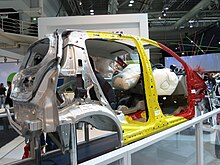Body in white
Body in white (BIW) refers to the bodyshell and refers to the stage in automobile construction in which the components of a body were connected to one another using one or more different joining techniques : welding (spot, MIG / MAG), riveting, Clinching, gluing, laser soldering, etc. BIW is used before painting and before the motor, chassis assemblies or cladding (glass, door locks / handles, seats, upholstery, electronics, etc.) are installed in the frame structure.
The name is derived from manufacturing methods before monocoques were made from steel. In the past, automobile bodies were manufactured by external companies on a separate chassis with an engine, suspension and attached fenders. Manufacturers built or bought wooden bodies (with thin, non-structural sheet metal on the outside) to attach to the frame. The bodies were painted white before the final color.
A folk etymology for body in white suggests that the term is derived from the appearance of a body after it - despite the actual gray color of the primer - has been dipped in a white primer bath (primer paint). This could also refer to when car bodies were made from wood - all wood products, furniture etc. are considered “in white” when they are in the raw wood stage prior to finishing / painting.
In car design, the body in white phase refers to the phase in which the final contours of the body are worked out in preparation for ordering the expensive series punching tool. In order to transform a clay model from the design studio into a body in white ready for series production, extensive computer simulations on crash behavior , manufacturability and vehicle aerodynamics are required.
Manufacturers may offer BIW cars for racing drivers who then replace up to 90% of the car with spares. Niche manufacturers like Ruf Automobile base their cars on BIWs from other manufacturers.
Related terms
A related term in the automotive industry is “ body in black ”. This may refer to a vehicle body made from alternative materials such as composites rather than traditional metal; these composites, such as carbon fiber reinforced plastic , are more black than white. " Body in black " can also refer to a step in the design process in which a model of a new vehicle skin is created in order to take accurate measurements during the design and preproduction process.
Individual evidence
- ↑ The Auto Insider: GM Performance Parts To Offer $ 7,000 Body-In-White New Camaro (en-US) . In: Jalopnik , December 26, 2008. Retrieved March 22, 2018.
- ↑ PlasticsToday Staff: Carbon fiber body-in-black wins design accolade . In: PlasticsToday , UBM indians, March 8, 2012. Retrieved July 1, 2018.
- ↑ Automotive composites - in touch with lighter and more flexible solutions . In: Axon , Axon Automotive, April 1, 2013. Retrieved April 13, 2018.
- ↑ How Porsche ensures the quality of its products: What do the terms cubing, exterior master jig and body-in-black mean? Insights into the production process at Porsche . In: Porsche News , Dr. Ing.hc F. Porsche AG., April 5, 2016. Retrieved April 13, 2018.
